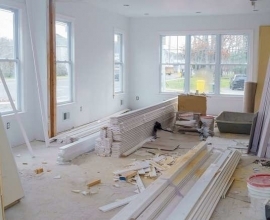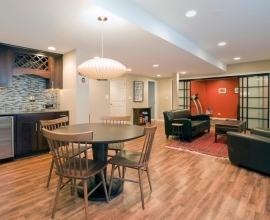Which is the Perfect Countertop for Your Kitchen Renovation?
When choosing the right countertop for your kitchen renovation in Ottawa, there are a variety of factors to keep in mind. While countertops are a visual focal point of every kitchen, each countertop material also comes with its own maintenance requirements, budgetary impacts and thickness options that should all be considered before making a final selection. In this post we will take a brief overview of some countertop selections and the important factors related to each.
Granite
Granite countertops are natural stone, very durable and boast a high scratch, chip and heat resistance rating. Granite is therefore very hard to damage and is a long-lasting solution for kitchen countertops. In fact, these natural stone surfaces are so scratch resistant that you can even cut on them with a knife (although this is not recommended as it will quickly dull your knife).
In addition to these functional benefits, granite countertops look great as they have a sleek and smooth surface that is also unique for each installation since the countertops come cut from a natural stone. Granite also boosts the re-sale value of your home as it can visually renew even the most outdated kitchen.
While granite boasts excellent stain and scratch resistance, there are some drawbacks to keep in mind. Granite is one of the most expensive countertop selections and is also a porous material, so it must be initially coated with a sealant in order to protect the surface and then re-coated every six months to two years (depending on manufacturer recommendations) to maintain the seal. Usually, the initial seal will have been applied by the manufacturer along with provided instructions on how to properly care for your new countertops.
The good news is that, once sealed, granite countertops will keep most liquids from staining or being absorbed, and require only cleaning with a mild detergent and warm water. With that being said, take care not to leave spilled wine on your granite countertops as they still can stain if not properly sealed. Also, avoid vinegar-based and acidic cleaners on granite as they can damage the sealant. It is best to think of granite as resistant to stains, not impermeable.
In terms of thickness, granite is sold in two main options for kitchens: 0.75 inch and 1.25 inch. The first difference between the two thicknesses is the look. 1.25 inch is obviously thicker and many people like this look as it appears more durable and substantial for kitchen applications, while others prefer 0.75 inch because it takes less space and appears sleek and modern. Like most decisions based on aesthetics, the choice is entirely up to the customer.
While it is true that 1.25 inch cuts are thicker, the fact that the material is granite means that whether you choose 0.75 inch or 1.25 inch, both are durable and rarely crack. Keep in mind that the 1.25 inch cut is clearly more granite and therefore will be more expensive.
Finally, when installing granite, one must always choose an edge profile. Edge profiles are basically the shape that the edge of your granite countertop will take. There are numerous edging selections to choose from, such as straight edge, bevel and bullnose. While straight edge is a standard edge and is not considered an upgrade, other edge profiles require work to achieve and will cost more for your kitchen renovation.
Quartz
Quartz slabs are man-made and engineered from a combination of ground quartz, binding resin and color pigmentation. Quartz is very durable and thanks to the pigmentation, is available in a wide variety of colors and patterns during manufacturing. In addition, quartz requires no sealant as the binding resin that is used in the manufacturing process makes the surface non-porous.
In terms of thickness, quartz is similar to granite as the most popular choices for the kitchen are 0.75 inch and 1.25 inch and again, the choice between the two is mostly cosmetic.
There are also numerous edging profiles available for quartz as we would find with granite. Manufacturers will usually have a complete brochure listing all of the various options.
Quartzite
Even harder than both granite and quartz, quartzite is another beautiful natural stone countertop option.
Quartzite is a natural stone that often features beautiful patterns and color options not found in granite due to the presence of natural minerals, iron oxide and impurities found in the stone. These give each quartzite countertop a one of a kind natural look and pattern that can really make a kitchen come to life. This beauty comes at a cost, however, as quartzite is an even more expensive kitchen countertop selection than granite.
Just like granite, quartzite requires sealing prior to use in order to protect the surface from staining and additional sealing on an annual basis to preserve the sealant. Also like granite, abrasive or acidic cleaners should be avoided in favor of a simple solution of mild soap and warm water.
Like granite and quartz, quartzite is most commonly found in 0.75 inch and 1.25 inch thickness for kitchen countertops and numerous edging profiles are available to choose from.
What is the difference between quartz and quartzite?
Both are very durable, however quartzite is natural stone and more expensive and has the visual appeal of a natural stone whereas quartz is man-made and has the advantage of a wider selection of colors and patterns as it is manufactured.
While quartz requires no annual sealant due to the resin, it is more vulnerable to heat damage as this resin is plastic based and can melt in high heat, so never leave a hot pan on your quartz kitchen countertop without protection underneath.
Source: https://hollandrenos.ca/kitchen-renovation-countertop-ottawa/






